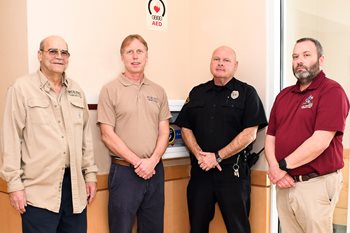
From left, Wor-Wic Community College employee Ronald Carey with the colleagues who helped him survive a heart attack: Gene Dyson, Linnie Vann and Daniel R. Webster Jr. Knowing CPR and how to use an AED helped them save Carey’s life.
No one would say a heart attack is a lucky break. “But if I had to have it, I was in the luckiest place,” said Ronald Carey, a plumber in the facilities department at Wor-Wic Community College.
It had seemed like a normal day to Carey and his coworker, HVAC mechanic Gene Dyson, as they headed to a boiler room to perform some maintenance last September. But walking through the Hazel Center door would be the last thing Carey remembered for quite a while.
“We came into the boiler room, and he just dropped,” Dyson said. Carey hit his head on a workbench on the way down. “There was blood and he was a little bit twisted, and I was afraid to move him at first,” said Dyson. “But then I saw he wasn’t breathing. He was turning blue.”
Dyson immediately called for help — a coworker called 911 — and then put his CPR training to work. Dyson first learned CPR while serving in the U.S. Navy, and had been in refresher courses at Wor-Wic.
Meanwhile, Linnie Vann, Wor-Wic’s director of public safety, had heard the call for help and came running. Part of his work is knowing the location of every automated external defibrillator (AED) on campus. “We have them in every building, including the satellite classroom at the Ocean Resorts Golf Club,” Vann said.
Vann said he has known CPR for decades. “But this was the first time I’d ever used it,” he said. “You’re always going to be nervous in a situation like this, but the AED prompts you and guides you.” While Dyson continued CPR, Vann prepared the AED. Then he shocked Carey’s heart back into a rhythm using the device.
Daniel R. Webster Jr., department head and assistant professor of emergency medical services, gets phone alerts when neighboring fire stations get a call, and has an app on his phone, PulsePoint Respond, that lets him know when CPR is needed nearby. He sprang into action. “I went to see if I could help,” he said. “When I got there, Ron was breathing; they had just shocked him.”
Webster said Vann and Dyson had done an excellent job, and their timely intervention made a crucial difference. “The longer your brain is without oxygen, the worse the outcome,” Webster said. “They had shocked him within a minute and a half.”
Dyson said although it felt like time had stopped, in reality everything happened very quickly to ensure Carey’s survival. His heart was beating, but his breathing was not regular enough to get him the oxygen his brain needed. Webster started rescue breathing; three students from his paramedic class, who were also firefighters, came to assist. When the Parsonsburg ambulance came, Webster and the three students rode along to ensure there was enough manpower to give Carey the fighting chance he needed.
Carey was treated at TidalHealth Peninsula Regional in Salisbury and released after nine days. Webster said the AED manufacturer, Stryker, provided data from the device for Carey. “It collected a lot of information about his heart rhythm,” Webster said.
Carey shared the information with his cardiologist, which helped in determining what had caused the heart attack. He had a pacemaker installed to regulate his heart’s rhythm and a stent placed in a partially blocked carotid artery. “I went to a neurologist afterward, and I was cleared to do everything,” he said.
Carey’s colleagues made a difference: He’s back to work and in good shape.
“He’s doing great — I have to remind him to slow it down now sometimes,” said Dyson with a laugh.
Carey is grateful for his coworkers’ lifesaving help. “If I had been at the beach, or working by myself, I might not be here,” Carey said. “I was blessed that Wor-Wic had the proper equipment and trained personnel. It’s nice to know you can depend on your coworkers. It’s like a family here.”
Vann says the incident is a critical reminder of the importance of CPR and AED training. “It might not be a coworker; it could be a friend or family member. As a matter of fact, for me, it was a friend and a coworker. It’s something everyone should know how to do — save a life.”
Webster couldn’t agree more. “It’s not something you want to have to use, but if you’re in a critical situation, being trained can be the difference between life and death,” he said.
To sign up for a basic life support course or renewal, visit www.worwic.edu.